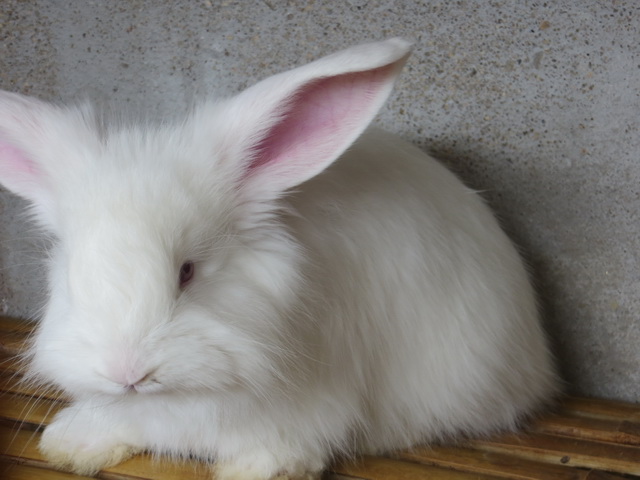1.长毛兔夜行性和嗜眠性
1. Night Travel and Sleepiness of Long Hair Rabbits
兔的原始祖先是野生穴兔。在大自然中,它们常常被肉食兽、猛禽等动物伤害。为了生存,它们白天不敢露面,躲在洞穴之中,夜间才出洞觅食。经过长期的自然选择,形成了兔子的夜行性和嗜眠性。夜行性,就是指兔子从黄昏到清晨这段时间里,表现得十分活跃,采食、饮水也多于白天。兔夜里食入饲料和水的量占全部日粮和水的75%左右。生产过程中需增加夜间饲喂。嗜眠性,就是指兔在白天吃饱喝足以后,很容易进人沉睡状态。兔除保持一定程度的听觉外,视觉消失,皮肤接受刺激后的反应也减弱或消失。生产上可以利用这一习性进行编耳号、注射、去势或其他小型手术。
The primitive ancestor of the rabbit is the wild cave rabbit. In nature, they are often injured by predators, raptors and other animals. In order to survive, they dare not appear in the daytime, hide in caves, and come out to feed at night. After a long period of natural selection, the nocturnal and sleepiness of rabbits were formed. Night travel means that rabbits are very active from dusk to early morning, and they eat and drink more water than during the day. The amount of feed and water consumed by rabbits at night accounts for about 75% of the total diet and water. Night feeding should be increased during the production process. Sleepiness refers to the fact that rabbits can easily fall asleep after having enough to eat and drink during the day. In addition to maintaining a certain degree of hearing, the rabbit's vision disappeared, and the response of the skin to stimulation also weakened or disappeared. This habit can be used in production for ear numbering, injection, castration or other minor operations.
2.长毛兔胆小,怕惊
2. Long-haired rabbits are timid and frightened.
兔表现得十分胆怯,特别是它的耳朵经常保持着高度的警惕性,一有异常声响,兔子就会在笼内乱跳乱撞,用后足有力地踏笼底,发出“啪啪”的响声,并发出低沉的叫声。这种现象对兔的健康有着不良的影响,轻则使兔掉膘、流产,重则急性死亡。
Rabbits show great timidity, especially their ears, which often maintain a high degree of vigilance. When there is an abnormal sound, the rabbit will jump and bump in the cage, tread on the bottom of the cage vigorously with hind feet, make a "crack" sound, and make a low cry. This phenomenon has a negative impact on the health of rabbits, which can cause fat loss, abortion and acute death.
3.长毛兔喜清洁干燥环境
3. Long-haired rabbits like clean and dry environment
兔卧在千净的笼底上,常用舌头舔其前肢和其他部位的被毛,以身上的污秽之物。兔的这种习性是它适应环境的本能,因为兔的抗病力很差,易感染病原微生物,不清洁和潮湿的环境,有利于病原微生物和寄生虫的繁殖,增加兔患病的机会。饲养兔很重要的一条原则,就是要求环境干燥和清洁。
Rabbits lie on the bottom of a clean cage, often licking their forelimbs and other parts of the coat with their tongues to remove dirt from their bodies. This habit of rabbits is its instinct to adapt to the environment, because rabbits have poor resistance to disease, are susceptible to infection of pathogenic microorganisms, unclean and humid environment, which is conducive to the reproduction of pathogenic microorganisms and parasites, and increase the chances of disease in rabbits. One of the most important principles in raising rabbits is to keep the environment dry and clean.
4.长毛兔耐寒怕热
4. Cold and Fear Resistance of Long Hair Rabbits
兔体躯被毛浓厚,皮肤汗腺不发达,保暖性能好而散热能力差,故能适应严寒而害怕炎热。当环境温度处于OC以下时,对兔影响不大;当环境温度达到30^C 时,长毛兔采食量会减少,繁殖能力下降;温度达到35'C 以上时,兔很容易中暑,甚死亡。长毛兔生长繁殖更适宜的温度是15~25C。但初生仔兔全身未长毛,防寒保暖是非常重要的。
Rabbits have thick coat, undeveloped sweat glands, good heat preservation and poor heat dissipation, so they can adapt to the cold and fear the heat. When the ambient temperature is below OC, it has little effect on rabbits; when the ambient temperature reaches 30 ^ C, the feed intake and reproductive capacity of long-haired rabbits will decrease; when the temperature reaches above 35'C, the rabbits are prone to heatstroke or even death. The optimum temperature for the growth and reproduction of long-haired rabbits is 15-25C. But the whole body of newborn rabbits is not hairy, so it is very important to keep warm and cold.
5.长毛兔同性好斗,群居性差
5. Long-haired rabbits are homosexual aggressive and poorly social.
长毛兔群居性差,不能像牛、马、羊那样集群放牧。群养长毛兔,尤其是成年同性公兔间常发生相互咬斗,有时咬得全身伤痕累累,失去种用价值。为此,性成熟后的公兔务必单笼饲养,以免造成不必要的损失。
Long-haired rabbits are poorly populated and can not herd in groups like cattle, horses and sheep. Growing rabbits, especially adult homosexual rabbits, often bite each other, sometimes causing a lot of scars and loss of seed value. For this reason, male rabbits after sexual maturity must be raised in a single cage in order to avoid unnecessary losses.
6.长毛兔穴居性
6. Burrowability of Long Hair Rabbits
长毛兔穴居性是指兔有打洞穴居的习性。这种习性也是其祖先下来的,只要不加以限制,它就要挖掘地道,,在地下洞中繁殖产仔。对于笼养兔来说,为顺应这一习性,要在笼中给母兔设产仔箱,供兔产仔时用。地面散养的兔,如果不控制其打洞,则会给饲养管理带来不便。
The cave dwelling habits of long-haired rabbits refer to the cave dwelling habits of rabbits. This habit is also a legacy of its ancestors, as long as it is not restricted, it will dig tunnels, reproduction in underground caves. For caged rabbits, in order to adapt to this habit, we should set up a litter box for the female rabbits in the cage for the use of the rabbits. Rabbits raised freely on the ground will bring inconvenience to feeding and management if they do not control their burrowing.
7.长毛兔啮齿行为
7. Rodenting Behavior of Long Hair Rabbits
成年长毛兔的牙齿共有28对。其中门齿3对:上颌2对,下颌1对;前白齿5对:上领3对,下颌2对;后白齿6对:上、下颌均为3对。而门齿中的一对齿叫作恒齿,出生时即有,以后也不出现换牙现象,不断地生长,兔必须通过经常啃咬硬物来摩擦牙齿,以保持上下颌牙齿齿面的吻合。兔的啮齿行为常常使兔笼和其他用具受到破坏。因此,应经常在兔笼中投放一些带叶的树枝树干、普通的木质棍棒,供它采食和随意啃咬磨牙。
There are 28 pairs of teeth in adult rabbits. Three pairs of incisors: two pairs of maxilla and one pair of mandible; five pairs of anterior white teeth: three pairs of upper collar and two pairs of mandible; six pairs of posterior white teeth: three pairs of upper and lower jaws. The first pair of teeth in the incisor teeth is called permanent teeth. They are born and do not change teeth. They grow continuously. Rabbits must rub their teeth by biting hard objects regularly to keep the maxillary and mandibular teeth aligned. Rabbit rodent behavior often destroys rabbit cages and other appliances. Therefore, some leafy branches, trunks and common wooden sticks should be often put into the rabbit cage for feeding and gnawing molars at will.


 发布日期:2019-02-12
来源:http://www.myxinhua.com 发布人:admin
发布日期:2019-02-12
来源:http://www.myxinhua.com 发布人:admin